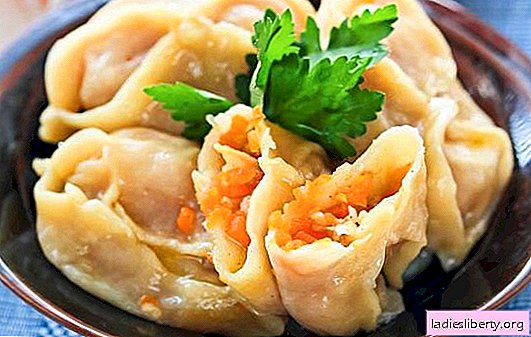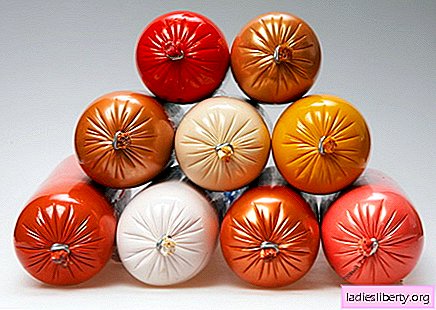
Manti recipes - a million! When it says "manti with pumpkin and meat", it seems that everything is defined by one name, and there is nothing to add. But this is not so! Dishes of Asian origin have so many different shades that even such a dish can be prepared in different ways, from the same ingredients.
Manti with pumpkin and meat - basic technological principles
Manti, like pilaf, are Tajik, Uzbek, Uigur, Kazakh and so on. Each recipe for their preparation has its own characteristics, although at the core there are only three main ingredients.
Meat
The stuffing meat in Asian cuisine is preferred to cut into small pieces. Minced meat has a special taste. If you want to try a real Asian minced meat dish, do not use a meat grinder or a food processor. This is a feature that relates to the method of mechanically preparing the product.
Now about the types of meat used for cooking: the traditional type of meat is lamb, but it is allowed to use veal and beef, of the exotic species - camel, horsemeat and goat. Since Muslims do not eat pork according to religious rules, and there is no such prohibition in the Orthodox canons, manti with pumpkin and meat can be cooked from pork. A small portion of fat tail fat is added to the minced meat.
Vegetables
Manti with pumpkin is a traditional Uyghur dish. In Tajik, Turkmen, Uzbek, and Kyrgyz cuisine, onions and potatoes are mainly used from vegetables. Sometimes, along with onions, jusai (wild garlic) is added to the minced meat, or various combinations of vegetables and meat are used to prepare the minced meat. For example, in Chinese cuisine, shrimp is used in combination with vegetables.
The dish became very popular even during the heyday of Soviet public catering, and it was then that a lot of minced meat options developed by technologists and chefs of the most popular restaurants appeared. The stuffing, along with pumpkin, onions and meat, included fruits and dried fruits (quince, dried apricots). Sometimes sesame is added to the stuffing.
Dough
Like dumplings or dumplings, manti is made from unleavened dough, but yeast dough is also found in some recipes. In Uighur and Dungan cuisine, yeast dumplings are prepared in the winter. If the dough is yeast, then the manti is first fried and then stewed. You can do without stewing, but in this case, the manti will look like fried pies.
To prepare the dough, wheat flour, water, salt are used; it should be tight, but elastic, so that it is convenient to roll thin cakes. Therefore, immediately after kneading, the dough is left for an hour to swell gluten. After cooking, the yeast dough is fermented for a long time, curing it several times. Most likely, the yeast is added not so much to make the manti rise, but to give the test a sour taste, since the yeast processes carbohydrates contained in the flour.
Sometimes eggs are added to the dough, but the amount of water added is reduced. The addition of eggs is convenient to use in cases where the semi-finished products are intended for freezing and storage, since the protein forms a dense crust when dried. Egg dough needs to be cooked a little longer.
Modeling
There is a legend that manti first appeared in China, and were invented by the commander as a symbol of sacrifice. Literally, translated from Chinese, "mantou" is a stuffed head. Most likely, for this reason, manti have a round and rather large shape. But in Asian and Eastern cuisines, there are other forms of modeling: oval, envelopes, triangles. Semi-finished product is covered up, both in the usual way, and with a wicker, a pigtail.
The size of the semi-finished product in Turkish cuisine is two times less than in the Tajik or Uzbek version, where the weight of one product in its raw form is 60-65 g.
"Highlight" dishes - sauce. It is prepared from tomatoes or dairy products, from vinegar and vegetable oil, but always with the addition of sharp shades and East Asian spicy herbs.
1. Manti with pumpkin and meat - the main recipe for a yeast-free dough for semi-finished products
Products:
Premium wheat flour 750 g (including 50 g per heat)
Water, warm 300 ml
Salt 10 g
Yield: 1.0 kg
Cooking method:
Sift the flour into a large bowl, add salt and pour water. Knead the steep dough and cover it with a damp cloth for an hour to swell gluten. The dough should be soft and plastic. After proofing, the dough is spread on the work surface and continues to knead. Then cut into small pieces and roll out with plaits. Harnesses are cut into pieces of 20 g and form round and thin cakes of them. The middle of each cake should be slightly thicker than the edges.
Next, the minced meat is placed in the prepared cakes, 40-45 g each, semi-finished products are formed and steamed.
2. Manti with pumpkin and meat - the main recipe for yeast dough for semi-finished products
Ingredients:
Pressed Yeast 75 g
Wheat flour (premium) 0.6 kg
Water 380 ml
Salt 16 g
Yield: 1,000 g
Cooking:
Sift the flour and add salt to it, mix. Yeast is kneaded and bred in warm water. Sifted flour is poured into the water gradually, kneading a cool dough. Cover it with a napkin and send for proofing for 3-4 hours. During this time, the dough is crushed 3-4 times. After rolling out the dough, cut into portioned pieces and, adding minced meat, prepare semi-finished products.
Manty from yeast dough is first fried in a pan, and then stewed.
3. Uyghur cuisine. "Kava-manta" - manti with pumpkin and meat from unleavened dough
For cooking:
Dough (recipe number 1) 1.0 kg
Minced meat:
Lamb, fat 850 g
Onions, 350 g
Pumpkin (pulp) 800 g
Salt, hot pepper, cilantro, garlic
Operating procedure:
Wash the lamb (fillet) and soak in ice water (put in the refrigerator overnight, in a sealed container). For those who do not like a specific smell: add vinegar or a few slices of lemon to the water. Then drain the water, wash again and cut into small cubes, with a side - 0.5-0.7 cm. Cut the onion and pumpkin with the same cubes. Chop cilantro and garlic very finely. Combine the ingredients of the minced meat, season with spices and lightly beat off.
From the rolled dough, cut the squares. In the center of each piece of dough, weighing 20 g, put 40-45 g of minced meat, and patch up the manti in the form of an envelope. If desired, you can use any other form of modeling.
Steam. When serving, use spicy seasoning made of pepper and vegetable oil, or pepper, tomato and garlic.
4. Uyghur cuisine. "Boldurgan-manta" - manti with pumpkin and meat from yeast dough
Product Composition:
Dough (recipe No. 2) 0.5 kg
For minced meat:
Lamb (sirloin) 500 g
Ramson ("jusai") 50 g
Pumpkin 450 g
Spices: red hot pepper (ground), black pepper, salt
Refined Oil (for frying)
Cooking Technology:
Cut the meat and pumpkin into small cubes. Chop the greens. Combine the minced meat, beat and let it brew for half an hour in the refrigerator. Cover the bowl with minced meat with foil or a tight-fitting lid.
Semi-finished products are formed as usual. Then they are lightly fried in boiling oil and brought to readiness in a double boiler.
"Boldurgan" means "magnificent." This type of product resembles fried pies to taste, and in a double boiler they are brought to readiness in order to remove harmful oil, which forms carcinogens when frying, although in some Asian peoples manti is sometimes first steamed and then fried.
5. The recipe from the chef: manti with pumpkin and meat, with Tajik sauce
Products:
For the test:
Flour 700 g
Water 180 ml
Eggs 3 pcs.
Salt 8-10 g
Yield - 1 kg
For minced meat:
Quince 400 g (Net)
Sesame 50 g
Garlic (to taste)
Pumpkin Pulp 600 g
Veal (fillet) 900 g
Bacon, pork 150 g
Salt, pepper mixture
For the sauce:
Sour milk, homemade 500 ml
Basil green
Parsley
Mint
Black and red ground pepper, salt
Cooking:
Beat eggs with water to prepare the dough. Then a fresh dough is prepared, as usual (see recipe number 1). Tip: since eggs are added to the fresh dough, do not leave it uncovered so that a crust does not form. Cut and roll the dough in small portions, holding the bulk under the film.
Cut the dough into isosceles triangles. Put minced meat in the center, twice as much in weight as a slice of dough. Turn the corners of the dough to the center and close up, connecting them together with a "pigtail".
For minced meat, cut all the ingredients into small cubes. Quince is best used in the stage of technical ripeness, when it contains a sufficient amount of tannin, which gives the special taste of minced meat. Remove the peel. If you wish, you can add wild garlic instead of garlic, finely chopped greens. Next, mix the components of the meat and keep it in the cold for about an hour, covering it with a lid.
To prepare the sauce, take fat homemade yogurt. Cut the greens, adding to taste. Add chopped herbs, salt and pepper to the yogurt. Kill the sauce with a blender.
The sauce can be served separately, or sprinkled with manti.
6. Oriental cuisine. "Khoshan" - manti with pumpkin and meat
Ingredients:
Dough, fresh and yeast - 0.5 kg each
For minced meat:
Lamb or beef (minced meat) 1 kg
Pumpkin 600 g
Fig 200 g
Vinegar, fruit 75 ml
Butter 120 g
Salt
Ground anise, bay leaf, hot pepper
Order of preparation:
Prepare fresh and yeast dough in equal parts, and combine it, mixing both parts. Roll round cakes of 40-50 g. Put the filling in the center of each circle, collect the edges of the dough to the center, folding them with a "skirt".
Minced meat preparation:
These ingredients are washed, cleaned and finely chopped, then combined. The minced meat is beaten and covered with a film, kept for 50-60 minutes in the cold.
Ready "Khoshan" manty is fried in heated vegetable oil. After they are placed in a saucepan, add salted water to 1/3 of the height of the products, cover and simmer for 5-6 minutes.
Manti is served hot, with oil and vinegar dressing, with the addition of chopped greens.
Manti with pumpkin and meat - useful tips and tricks
- When choosing a recipe for a dough, be sure to adjust the number of wet ingredients of the dough, taking into account the moisture content of the flour available.
- So that the dough does not "float" during the molding process, you need to check it in advance for gluten content. At home, this can be done in a simple way: take a pinch of flour in your mouth and chew. If a dense lump quickly forms from it, then you can safely get to work.
- To fix the “floating” dough, add part of the custard dough made from the same flour, and mix well. True, the volume will be more than planned, but the product will be saved. For "floating dough" you can use potato starch when kneading, sprinkling it on the work surface.
- Old meat has to be cooked for a long time to make it soft and juicy. It is better not to use such meat for cooking dough products, because the dough will digest faster than the meat reaches readiness. This is especially true for products such as manti, where for minced meat, they cut the meat into pieces, rather than grind it through a meat grinder.











